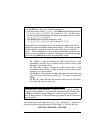
Page 9-1
Chapter 9
Vectors
This Chapter provides examples of entering and operating with vectors, both
mathematical vectors of many elements, as well as physical vectors of 2 and 3
components.
Definitions
From a mathematical point of view, a vector is an array of 2 or more elements
arranged into a row or a column. These will be referred to as row and column
vectors. Examples are shown below:
Physical vectors have two or three components and can be used to represent
physical quantities such as position, velocity, acceleration, forces, moments,
linear and angular momentum, angular velocity and acceleration, etc.
Referring to a Cartesian coordinate system (x,y,z), there exists unit vectors i, j, k
associated with each coordinate direction, such that a physical vector A can be
written in terms of its components A
x
, A
y
, A
z
, as A = A
x
i + A
y
j + A
z
k.
Alternative notation for this vector are: A = [A
x
, A
y
, A
z
], A = (A
x
, A
y
, A
z
), or A
= < A
x
, A
y
, A
z
>. A two dimensional version of this vector will be written as A
= A
x
i + A
y
j, A = [A
x
, A
y
], A = (A
x
, A
y
), or A = < A
x
, A
y
>. Since in the
calculator vectors are written between brackets [ ], we will choose the notation
A = [A
x
, A
y
, A
z
] or A = [A
x
, A
y
, A
z
], to refer to two- and three-dimensional
vectors from now on. The magnitude of a vector A is defined as |A| =
. A unit vector in the direction of vector A, is defined as e
A
=
A/|A|. Vectors can be multiplied by a scalar, e.g., kA = [kA
x
, kA
y
, kA
z
].
Physically, the vector kA is parallel to vector A, if k>0, or anti-parallel to vector
A, if k<0. The negative of a vector is defined as –A = (–1)A = [–A
x
, –A
y
, –A
z
].
Division by as scalar can be interpreted as a multiplication, i.e., A/k = (1/k)⋅A.
Addition and subtraction of vectors are defined as A±B = [A
x
± B
x
, A
y
± B
y
, A
z
± B
y
], where B is the vector B = [B
x
, B
y
, B
z
].
There are two definitions of products of physical vectors, a scalar or internal
product (the dot product) and a vector or external product (the cross product).
The dot product produces a scalar value defined as A•B = |A||B|cos(θ),
]2,5,3,1[,
6
3
1
−=
⎥
⎥
⎥
⎦
⎤
⎢
⎢
⎢
⎣
⎡
−
= uv
222
zyx
AAA ++


















